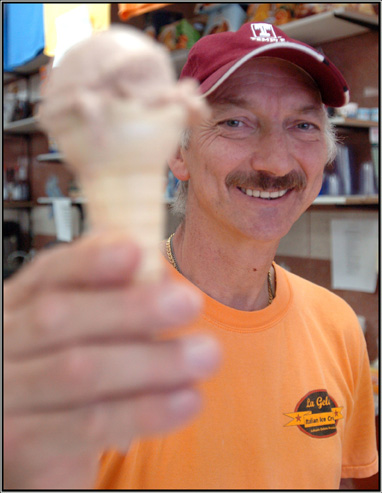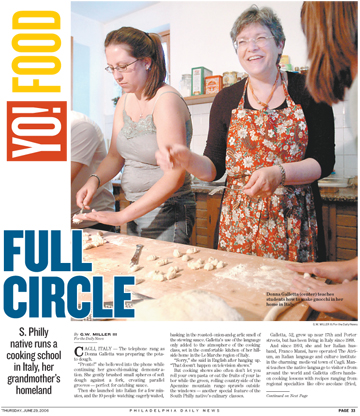The Gelato Guy
An Italian native who was raised in South Philly is bringing the Italian treat to a restaurant near you.
Published on July 12, 2007 in the Philadelphia Daily News.
Giancarlo D'Orazio was a data processor who feared he was going to lose his job despite his 29 years of experience in that field.
So one day, he began searching the Web for work. On a lark, he Googled "gelato making."
As he started reading about the process, he began to reminisce about his childhood back in the Abruzzi region of Italy. D'Orazio, 55, remembered going to the gelateria a few times every summer for a zabajone gelato - an egg-nog-flavored frozen Italian treat similar to ice cream.

D'Orazio was indeed laid off a few weeks later, but by then he wasn't worried.
Rather than try to find another job in data processing - a career he loved - in May 2005 he opened La Gelato Cafe, an Italian-style eatery in Sewell, N.J., featuring his homemade gelato. Now D'Orazio's cafe has a steady clientele, and his traditional Italian treats are served at restaurants around the Philadelphia region, from Il Portico on Walnut Street to the Centerton Country Club in Pittsgrove, N.J.
"From just kidding around, it became a serious thing," D'Orazio recalled with a smile.
He's riding the wave of gelato popularity in Philadelphia that started when Capogiro Gelateria opened at 13th and Locust streets in 2002. Gelato is now common at restaurants around the Delaware Valley, and several other gelaterias have opened in the city, from Cafe Toscano near Independence Hall to a second Capogiro near Rittenhouse Square.
"Gelato is like what cappuccino and caffe latte were 10 or 12 years ago," D'Orazio said. "When you asked for a cappuccino back then, people would say, 'What is that?' "
D'Orazio grew up in Orsogna, Italy, a village of 4,000 people situated between the mountainous spine of Italy and the Adriatic Sea. He was the youngest of 10 children. A few of his older siblings started making their way to America in the 1950s because there weren't many jobs in their region.
When D'Orazio's father, a shoemaker, passed away in the early 1960s, D'Orazio's mother, a traditional Italian housewife, made arrangements to move the remainder of the family to South Philadelphia. Giancarlo D'Orazio was 15.
More than 40 years later, the affable D'Orazio still has a charmingly sing-song Italian accent, and when he's speaking to his bilingual friends, the conversation quickly turns from English to Italian and back to English without hesitation.
During the months between the end of his data-processing job and the opening of his cafe, D'Orazio learned the art of making gelato. He took classes at "Frozen Desserts University," a crash course run by the famed Italian gelato-machine company Carpigiani.
The entire business was new to him. No one in his family had been a gelato maker. "Actually, they're all surprised at what a change I've made!" he remarked.
In the back of his strip-mall cafe in Sewell, D'Orazio mixes ingredients and quick-freezes them in an Italian-made Carpigiani machine. He makes 24 favors, from traditional nocciola (hazelnut) and stracciatella (chocolate chip) to more modern creations such as Snickerone (chocolate and peanut butter with a Snickers-bar topping).
"I think my heritage took me here," said D'Orazio, a former president of the now-defunct Washington Township (N.J.) Sons of Italy club. "I wanted to make something authentic without offending American people."
He also makes five flavors of traditional ice cream and eight flavors of water ice, though in his opinion, "gelato is to ice cream what a lady is to a woman."
Where ice cream is made with a mix of cream and milk, gelato is made only with milk. There is less air in the denser, more intensely flavored gelato, and it contains only 4 to 6 percent fat. Ice cream is 14 to 16 percent fat.
During the warmer months, D'Orazio makes, on average, six 16-ounce batches of gelato a day, five days a week. He delivers it himself to the locations that serve his specialty, such as the new Cacia's Bakery on 2nd Street in Northern Liberties, Mancini's Catering in South Philly, and Valente's Pasta and Prepared Foods in Mount Laurel, N.J.
He also provides gelato for weddings and events.
"It's the new trend," D'Orazio said of the frozen treat. "It's coming of age in America, I guess."
D'Orazio's daughter Alicia, a 20-year-old Temple University student, also works in the cafe.
"Everybody asks, 'How are you not, like, 500 pounds?' " she said with a laugh, surrounded by desserts. "I try not to eat it all the time."
Giancarlo D'Orazio handed customer Max Fewell, 9, a nocciola gelato and smiled as the boy savored the treat.
"I think it's delicious," Max said. He doesn't have a favorite flavor. "They're all good."
Every once in a while, D'Orazio considers returning to data processing and keeping the gelato business on the side. He'd be happiest, however, with a set of drumsticks in his hand.
"If I was young enough and good enough, I'd be a musician," said D'Orazio, a drummer who once played in a band with Sal D'Angelo, owner of D'Angelo's Ristorante Italiano on 20th Street.
When D'Orazio started making gelato, D'Angelo was his first commercial client.
"It tastes more original than other gelato," said D'Angelo, a native of Sicily. "It brings back memories of eating gelato in the summertime as a child."
The compliment means a lot to D'Orazio.
"The Italian people, they're very hard to satisfy," he said. "They're born to criticize. When I get a compliment from them, it means a lot."
* To see a video of Giancarlo D'Orazio talking about his gelato, click here.



